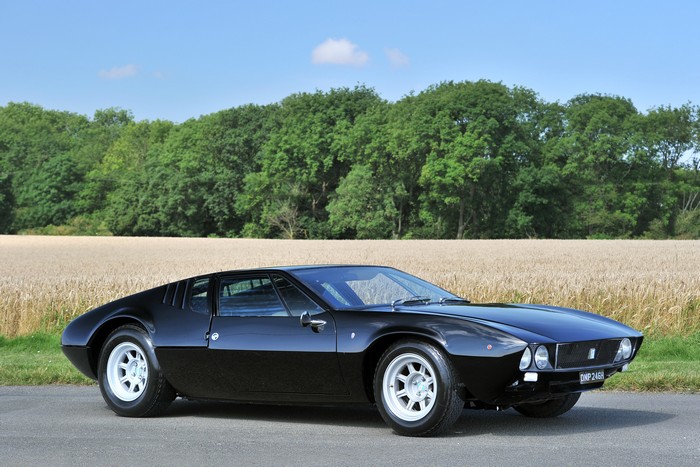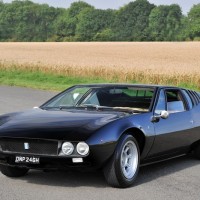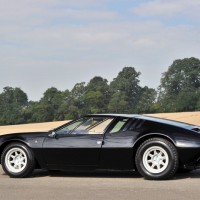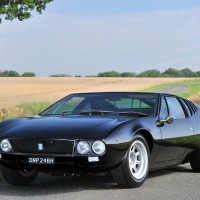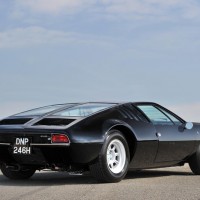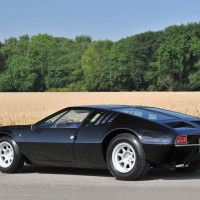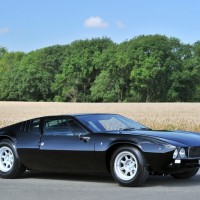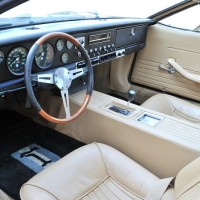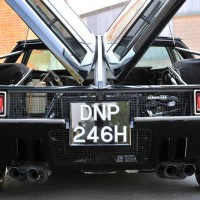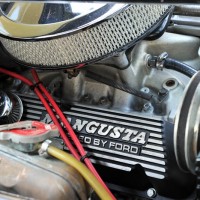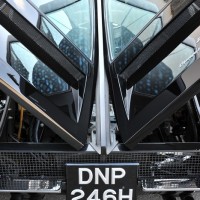One of the very first supercars, the Mangusta effectively established DeTomaso as a serious automobile manufacturer on its arrival in 1967. The Mangusta (mongoose) was powered by a mid-mounted 289-ci Ford V8 engine. Also used to power Ford’s GT40 Le Mans challenger, the iconic 289 produced 306 horsepower as installed in the Mangusta, which also used the GT40’s early-type ZF transaxle.
Later Mangusta production used the less-desirable Ford 302-ci engine, producing only 220 horsepower, together with a later ZF transmission. Carrozzeria Ghia’s Giorgetto Giugiaro contributed the striking gull-wing door coachwork, which had been intended for Giotto Bizzarrini.
With 300 or so horsepower on tap, the aerodynamic Mangusta was good for a top speed in the region of 155 mph. Disc brakes all around helped restrain this outstanding performance. DeTomaso enjoyed close links with the Ford Motor Company at this time, and the American firm helped put the Mangusta into larger- scale production than would otherwise have been possible. Nevertheless, only 401 examples were made between 1967 and 1972, and any Mangusta is extremely rare; this example particularly so given that it is one of the first made and therefore has the most sought-after specification.
Chassis number 8MA542 was built for the European market, for which 150 were made, and not for the United States, which already had federal emissions and other particular requirements by 1969. It is a rare four-headlight model built prior to the standardization of two pop-up headlights for both the European and U.S. markets, which lasted for the rest of Mangusta production. Very early cars such as this can also be identified by their folding bucket seats, whereas later examples were manufactured with a fixed back.
This car also retains its original air-conditioning system, which has been carefully rebuilt to be fully functional, and its European specification instruments. This car has recorded the exceptionally low figure of only 40,500 kilometers (approximately 25,000 miles) from new, and close inspection shows it to be exceptionally original, even down to the 43-year-old, slightly threadbare carpet in the driver’s footwell!
With careful ownership throughout its 43 years, the car also benefited from many years spent in the sunny and dry state of Arizona. On arrival in the U.K., the Mangusta underwent extensive servicing by Newlands Motors and has covered fewer than 100 miles since securing its MoT. Finished in black with light tan interior, 8MA542 is stunning to look at, exciting to drive and sounds just like a GT40.
SCM Analysis
Detailing
| Vehicle: | 1969 DeTomaso Mangusta Coupe |
| Number Produced: | 401 |
| Original List Price: | $11,500 |
| Tune Up Cost: | $475 |
| Chassis Number Location: | Stamping on frame member in right rear corner of engine compartment, data tag in front compartment on bulkhead |
| Engine Number Location: | Intake side of block |
| Club Info: | Mangusta International |
| Website: | http://www.mangustainternational.com |
| Alternatives: | 1967 Iso Grifo GL 1969 Chevrolet Corvette 427 1970 Monteverdi HAI 450SS |
This car, Lot 126, sold for $209,490, including buyer’s premium, at Bonhams’ Goodwood sale on September 15, 2012.
The Mangusta is one of those cars that have a reputation. It’s the kind of car you might like to take out for a long, hard ride on fast, empty roads, but afterward you wouldn’t want to take home to meet your parents. Seriously, as with other American-powered Italian sports cars, the products of DeTomaso, like those of Rivolta, didn’t get their due and were regarded as over-powered and half-baked, not suitable for connoisseurs of fine GTs.
Compared to DeTomaso’s first mid-engined offering, the Vallelunga, the Mangusta was far more developed, although the word “refined” might be a stretch. The Vallelunga’s “racer for the street” rawness was replaced with a well-trimmed leather cockpit, reasonably sorted and not too horribly non-ergonomic for the time.
Styled by Giorgetto Giugiaro for Ghia, the Mangusta’s shape is, for the character of the car, the most appropriate that could be imagined. If you picture in your mind’s eye a former U.S. Marine boxer who now works in security for an Italian prince, the Mangusta’s superb blend of raw, muscular strength and sleek Italian style is obvious. How else should a GT with the same powerful Ford V8 that powered the GT40 look when born in Turin?
A challenging drive
As with early 911s, the Mangusta is not impossible to drive but simply requires attention and commitment. If you aren’t sure of yourself and in command of the car, you can get into really bad trouble.
The Mangusta doesn’t suffer fools gladly. That said, those limits are pretty hard to reach unless you’re really trying.
The color scheme of this particular car makes it look much more sophisticated than the red most often seen. It’s easy to imagine this being driven by a young businessman.
Mangusta International estimates that 250 of the 401 cars built still exist, a very high survival rate for a car so many claim to be both undriveable and horribly rust-prone. It proves, of course, that neither is actually the case.
Nice car plus receptive market equals big price
The catalog photos show a bit of waviness in the paint at some angles, although the panel fit looks quite good. It was reported to have covered a mere 100 miles since passing its MoT, or road safety test, and had recent receipts for maintenance work totaling £12,000 — more than $19,000. SCM’s man on the scene, Senior Auction Analyst Paul Hardiman, shared his notes on the Mangusta with me, reinforcing what I deduced from the catalog: “Very straight and tidy, excellent glassfibre (for a DeTomaso), couple of tiny chips in paint but they hardly show, motor tidy, clean and refinished, 40,527 km, leather and other trim hardly worn.” He rated it at a U.S. Condition 2, which in the U.K. translates as 2+.
I wrote a profile of a 1969 Mangusta in 2008 (SCM October 2008, p. 38), a car that sold for $99,241 on July 11, 2008, at Bonhams’ Goodwood Festival of Speed auction.
In the piece, I noted that “I would not expect them to continue to sell at the considerable discount to an Iso Grifo as is the case currently. In a short time, this sale may be considered quite the bargain.” A top-condition 1970 small-block Grifo would have cost about $195k then. Now, that Grifo has drifted down a bit to the $175k area. Note that the big-block cars are in another league altogether. It would seem that the much rarer Mangusta has found its place in the sun. Well, not quite.
In analyzing the price paid, an interesting pattern seems to emerge. There are some cars such as the Mercedes-Benz 300SL or Ferrari 250 GT SWB which have almost uniform worldwide appeal and sell for a global market price. Others, such as a Plymouth Hemi ’Cuda or a Gordon Keeble, would find a very thin market indeed outside of the U.S. and U.K. respectively.
Looking at Mangusta prices, it would seem that the Brits pay a considerable premium for them, which is not reflected in U.S. offerings. The July 2008 Bonhams Goodwood sale of a #2 condition car for $99,241 was at the same time that very good driver with some cosmetic needs was sold by a U.S. dealer for half that price.
Today, this $209k U.K. sale can be contrasted with the $93k that another U.S. dealer just received for a 1969 Mangusta with a nice older restoration. Incidentally, both our subject car and that U.S. sale were “four-headlight” early European cars, which have typically brought a premium over later “pop-up” two-light examples.
On either side of the ocean, it’s clear that Mangusta values have risen strongly in the past few years. I would not expect to see U.K.-level prices here for quite a while, and this result may see a run on Mangustas leaving us for greener pastures. For us in the Colonies, I would have to pronounce this as quite well sold. ?
(Introductory description courtesy of Bonhams.)
